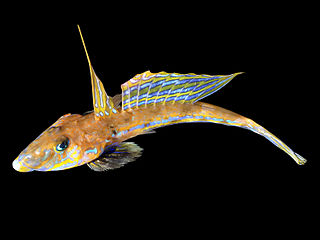
Dragonets are small, percomorph, marine fish of the diverse family Callionymidae found mainly in the tropical waters of the western Indo-Pacific. They are benthic organisms, spending most of their time near the sandy bottoms, at a depth of roughly two hundred meters. There exist 139 species of the fish, in nineteen genera.

Synchiropus splendidus, the mandarinfish or mandarin dragonet, is a small, brightly colored member of the dragonet family, which is popular in the saltwater aquarium trade. The mandarinfish is native to the Pacific, ranging approximately from the Ryukyu Islands south to Australia. It can usually be found in some of the warmer waters.
Victor Gruschka Springer is Senior Scientist emeritus, Division of Fishes at the Smithsonian Institution's National Museum of Natural History in Washington, D.C. He is a specialist in the anatomy, classification, and distribution of fishes, with a special interest in tropical marine shorefishes. He has published numerous scientific studies on these subjects; also, a popular book called "Sharks in Question, the Smithsonian Answer Book" 1989.

The sixgill stingray is a species of stingray and the only extant member of the family Hexatrygonidae. Although several species of sixgill stingrays have been described historically, they may represent variations in a single, widespread species. This flabby, heavy-bodied fish, described only in 1980, is unique among rays in having six pairs of gill slits rather than five. Growing up to 1.7 m (5.6 ft) long, it has a rounded pectoral fin disc and a long, triangular, and flexible snout filled with a gelatinous substance. It is brownish above and white below, and lacks dermal denticles.

The checkerboard wrasse is a fish belonging to the wrasse family. It is native to the area including the Indian Ocean to central Pacific Ocean.

Callionymus is a genus of dragonets found mostly in the Indian and Pacific oceans with a few species occurring in the Atlantic Ocean.
The short-snout sand-dragonet is a species of dragonet native to the eastern Indian Ocean and the western Pacific Ocean where it is found at a depth of around 8 metres (26 ft). It prefers muddy or sandy substrates, preferring areas near river mouths or estuaries. This species grows to a length of 6.5 centimetres (2.6 in) TL. The specific name honours Dirk François Schaap, a Dutch colonial administrator in the Dutch East Indies who lived on Bangka Island, Sumatra, who found this species.

Callionymiformes is an order of bony fish containing two families, the dragonets Callionymidae and the Draconettidae. In some taxonomies these families make up the suborder Callionymoidei of the wider grouping known as Perciformes, Nelson (2016) recognised the order but subsequent workers have suggested that if Callionymiformes is recognised as an order then the order Syngnathiformes is rendered paraphyletic and include Callionmyoidei within that taxon.
Synchiropus claudiae, the Claudia's dragonet, is a species of fish in the family Callionymidae, the dragonets. It is found in the Western Central Pacific.
Synchiropus grandoculis, the Western Australian bigeye dragonet, is a species of fish in the family Callionymidae, the dragonets. It is found in the Eastern Indian Ocean along Western Australia.
Synchiropus minutulus, the minute flagfin dragonet, is a species of fish in the family Callionymidae, the dragonets. It is found in the Western Indian Ocean.
Synchiropus novaecaledoniae, the West Jumeau bigeye dragonet, is a species of fish in the family Callionymidae, the dragonets. It is found in the Western Central Pacific.
Synchiropus novaehiberniensis, the New Ireland dragonet, is a species of fish in the family Callionymidae, the dragonets. It is found in the Western Pacific Ocean.
Synchiropus springeri, the Springer's dragonet, is a species of fish in the family Callionymidae, the dragonets. It is found in the Western Pacific.
Synchiropus moyeri, the Moyer's dragonet, is a species of fish in the family Callionymidae, the dragonets. It is found in the Western Pacific.
Synchiropus delandi, the Deland's dragonet, is a species of fish in the family Callionymidae, the dragonets. It is found in the Western Central Pacific from Philippines to Indonesia.
Synchiropus grinnelli, the Philippines dragonet, is a species of fish in the family Callionymidae, the dragonets. It is found in the Western Central Pacific from Philippines to Indonesia.
Synchiropus monacanthus, the deep-water dragonet, is a species of fish in the family Callionymidae, the dragonets. It is found in the Western Indian Ocean and Southeast Atlantic Ocean from Zanzibar, Tanzania to Port Alfred, South Africa.
Synchiropus postulus, the dwarf dragonet, is a species of fish in the family Callionymidae, the dragonets. It is found in the Western Indian Ocean.
Centrodraco otohime is a species of fish in the family Draconettidae, the slope dragonets. It is found in the Northwest Pacific Ocean.






